If you’re considering buying a car, there’s a good chance you’ll wind up taking out an auto loan. The majority of drivers rely on car loans to cover all or a portion of their automotive purchase. In fact, Americans have about $1.18 trillion in car loans in total.
The interest rate on your car loan has a big impact on how much you pay over the life of your loan. It’s a percentage of your total balance charged by the lender or financial institution in exchange for the loan. The higher the rate, the more money you’re paying in interest each month until your loan is paid off.
That’s why it’s so important to make sure you get a good rate on your loan when buying a car. It raises or lowers the price you pay for the vehicle in total.
Whether you’re buying a new car or hoping to lower how much you’re paying for your current one, here’s how to determine whether you have a good interest rate on your loan.
Why Interest Rate Matters
The interest rate on your car loan is the fee you pay to the auto loan company for loaning you the cash up front. Lenders calculate monthly interest based on the principal or the total amount owed.
Note that interest rate and annual percentage rate (APR) are not the same. While interest rate is the annual cost of borrowing money and is calculated based on the principal, APR reflects the total cost of the car loan and includes the principal, interest, fees, and other things you rolled into the loan.
As you pay down the principal and your total amount owed lowers, so the amount you pay in interest lowers as well.
One of the simplest ways to determine how much you will pay in interest is to use an auto loan calculator online. Simply plugging in a few of the basics — the price of the car, your down payment, the length of the loan, the APR, and sales tax — will tell you the total amount of interest you will pay over time.
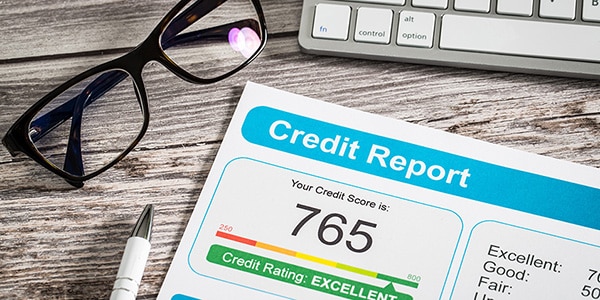
How Credit Affects Interest Rate
To get the lowest rates possible, you need to make sure you have great credit and are in good financial standing with your current lenders. Credit is rated by tiers, with tier 1 being the highest and tier 3 being the lowest. The higher the tier, the less information you may have to provide when applying for a loan.
Your credit score is determined by payment history, current account balances, length of your credit history, types of credit accounts, and other factors.
Every lender has their own underwriting guidelines, so it’s important to find a lender who will work with your credit profile and offer the most competitive loan terms.
It also helps if you use a cosigner who has good credit, choose a shorter loan period, or pay a bigger down payment to lower the overall loan amount.
You also want to check with multiple lenders, including online lenders, to “shop around” for the best rate. You may also consider heading into the car shopping process with pre-approval and multiple loan offers so you don’t risk winding up with a higher rate financing at the dealership.
What Criteria Financial Institutions Use to Determine Interest Rate
Financial institutions — such as banks and credit unions — determine loan rates based on a borrower’s credit. Lenders give borrowers with better credit ratings a lower interest rate because they are considered lower risk and they’re much more likely to pay back the loan in full. Every financial institution uses different criteria to determine whether someone is creditworthy.
Although every lender is different, they typically evaluate a borrower’s creditworthiness based on their credit report, which takes into account things like total debt in loans, credit cards, mortgages, and more as well as payment history, credit usage, and other factors. The average loan rates vary widely depending on where a borrower’s credit score falls.
Every financial institution evaluates credit differently and may provide you with a rate that’s higher or lower depending on many unique factors.
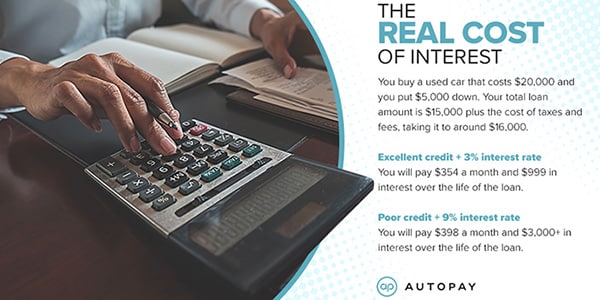
The Real Cost of Interest
Here is a simple example to help you see exactly how much interest rate affects your monthly payments and total interest paid.
Let’s say you want to buy a used car that costs $20,000 and you put $5,000 down as a down payment. That means your total loan amount is $15,000 plus the cost of taxes and fees, taking it to around $16,000.
If you have excellent credit and are able to secure a low interest rate of 3%, you will pay $354 a month and $999 in interest over the life of the loan.
If you have bad credit or no credit history, you’ll have a higher interest rate on your used car loan. In this example, let’s say your interest rate is 9%. In this case, you will pay $398 per month and over $3,000 in interest over the life of the loan.
As you can see, having good credit and securing a lower auto loan interest rate can save you thousands of dollars over the life of your loan. This means more money in your pocket for savings, monthly bills, and more.
How to Get a Good Interest Rate for a Car
So how do you get the best interest rate on your car purchase or refinance? Before you submit a single loan application, you want to make sure you follow the tips below.
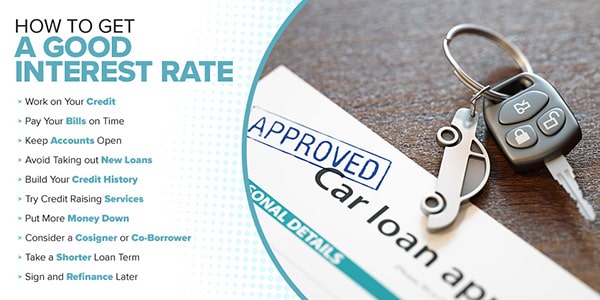
Work on Your Credit
Boosting your credit score goes a really long way in securing the best auto loan rates.
So, how do you do that, exactly?
Pay Your Bills on Time
Always pay at least the minimum balance on time on your current loans each month. You may also consider paying debts down more aggressively to lower your overall credit use, which could boost your score.
Keep Accounts Open
As tempting as it may be to close old credit cards you’re not using, especially if they have high annual fees, don’t. Keep them open to help lengthen your average credit age.
Avoid taking out new loans
It’s also a good idea to avoid taking out any new personal loans or credit cards during this time since these can put hard inquiries on your credit and cause it to drop. If approved, it will also shorten your average credit age, which doesn’t look good to the bank.
Build Your Credit History
If you don’t have much credit history, consider putting utility bills in your name, signing up for a secured credit card, or asking a loved one you trust — and who trusts you! — to add you as an authorized user on one of their accounts.
Try Credit Raising Services
Many companies offer services to help you raise your credit score fast. For example, Experian offers an option that claims to raise your FICO score instantly.
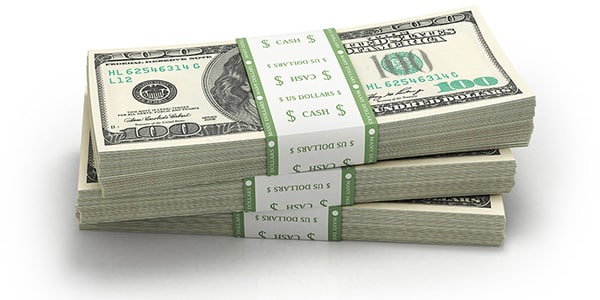
Put More Money Down
Increasing your down payment is another great way to get a lower interest rate and smaller monthly loan payments. Not only will a higher down payment help convince the bank of your creditworthiness, but it will also lower the amount of interest you pay in total and each month since your interest payment is based on the principal loan amount.
Consider a Cosigner or Co-Borrower
To get a better rate, you may want to consider partnering with a cosigner or co-borrower. Though similar, a cosigner and co-borrower are not the same.
A cosigner is a person who signs the car loan alongside you, agreeing to pay the loan if you fail to do so. A co-borrower is similar, but will share ownership of the car as well as responsibility for the payments. Co-borrowers should both have access to the money used to buy the car.
Note that lenders may not allow a cosigner, only a co-borrower. This is because, in general, lenders don’t like when someone else’s credit is used to secure a loan for someone else. They expect the person on the loan to be the one who will own the collateral.
Often a parent, friend, aunt, or uncle, the cosigner signals to the automotive finance company that you are worthy of a lower interest rate. This is a huge thing to ask because you’re effectively asking someone else to put their credit on the line for you, so make sure to only use this option if you’re sure you can pay it back.
This is a great route to take for anyone without a strong credit history or those with poor credit who have improved their financial standing and are now able to pay loans on time each month.
Take a Shorter Loan Term
Auto loans are generally offered in different term lengths ranging from 24 months (two years) to 84 months (seven years). When you stretch your loan across a longer time period, it lowers your monthly payment, which means more cash in your pocket.
But there is a downside — If you take too long to pay off your loan, you may end up with a loan that exceeds the value of your car. That puts you and the lender at risk should your car be totaled and you owe more on the loan than the car is worth. If you have a guaranteed asset protection (GAP) waiver, you’ll be protected if your car is totaled and you still owe money on it.
Opting for a shorter loan period may be a great way to get the best interest rate based on your credit. When looking at your loan options, play with different terms to help determine how the rates vary depending on the loan term length you choose.
Sign and Refinance Later
If you aren’t able to secure the lowest interest rate possible that doesn’t mean you shouldn’t take out a car loan at all.
One great strategy is to take your less-than-ideal loan rate and refinance later. Having an auto loan can help you build good credit and ensure that you get a better rate later. After a few months of timely payments, you may see your credit score improve, and you may qualify for better rates than when you first bought your car.
You can refinance your new car loan in two or three months from the time you sign on, but it may be more beneficial to wait until you’ve boosted your credit history and score so you secure a lower rate.
Plus, if the interest rate savings are large enough, you may even end up paying less for the car by the time you’ve paid off the loan, just by getting a lower rate Use an auto refinance calculator to see how much you can save with a better interest rate.

Find a Rate You’re Comfortable with
If you’re a new borrower or are working on your credit score, taking a higher rate isn’t always a bad thing since it can help you boost your credit standing and helps get you on the road faster. Ultimately, there’s no magic number when it comes to the ideal APR. A good interest rate is one you’re comfortable with and one that fits into your budget.

